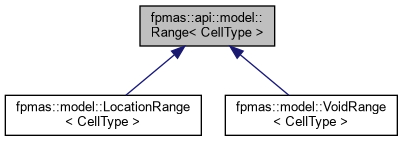 |
fpmas 1.6
|
 |
fpmas 1.6
|
#include <spatial_model.h>

Public Member Functions | |
| virtual bool | contains (CellType *root, CellType *cell) const =0 |
| virtual std::size_t | radius (CellType *origin) const =0 |
Range API.
Ranges might be associated to SpatialAgents to build their mobility and perception fields.
Ranges are assumed to be continuous: for any given root, if this->contains(root, cell), the current Cell network must contain a path from root to cell such that this->contains(root, cell_path) is true for any cell_path on the path. This is required for the DistributedMoveAlgorithm to work properly.
|
pure virtual |
Returns true if and only if cell is contained in this range, considering that the range uses root as its origin.
In practice, root is usually the location of the SpatialAgent to which this range is associated.
Notice that root and cell can be DISTANT. In consequence, it is not safe to use root's or cell's neighbors in this method implementation.
| root | origin of the range |
| cell | cell to check |
Implemented in fpmas::model::VoidRange< CellType >, and fpmas::model::LocationRange< CellType >.
|
pure virtual |
Returns the radius of this range, i.e. a value greater or equal to the maximum shortest path length between origin and any cell contained in this range, considering origin as the location of the object to which this range is associated.
Notice that such path length must be understood as a "graph
distance", and not confused with any other type of distance that might be associated to CellType.
It represents the maximum count of edges on a shortest path from origin to any point in the range in the current Cell network. In consequence, implementations will probably depend on the underlying environment implementation on which this range is used (Grid, generic graph, geographic graph...).
Here is a trivial example. Consider that the current environment (or "Cell network") is a simple chain of cells, with a distance of 1km between each cell. The underlying graph might be represented as follow: 1 – 2 – 3 – 4 – 5 – 6 – ...
Now, let's implement a Range that represents the fact that a SpatialAgent can move 2km to its left or to its right. Considering the definition above, the radius returned by this method will be 2, since in the current environment a SpatialAgent associated to this Range will be able to move at most two cells to its left or to its right, whatever its current position is (so, in this case, there is no need to use the origin parameter).
| origin | origin cell of the range (typically, the location of the agent associated to the range) |
Implemented in fpmas::model::VoidRange< CellType >, and fpmas::model::LocationRange< CellType >.